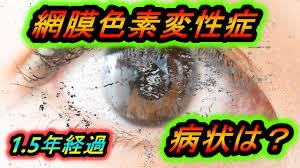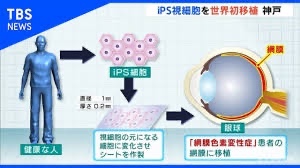

iPS photoreceptors: Safety confirmed!
– Post-transplant patients can see letters!ー
-World’s first surgery using iPS cells to treat retinitis pigmentosa-
Japanese Society of Clinical Ophthalmology:
Presented at the Japanese Society of Clinical Ophthalmology held in Tokyo.
“One patient who could not see letters”
“The function has improved to the extent that the letters can be seen.”
Retinitis Pigmentosa:
The number of “photoreceptors” in the retina, which convert light into electrical signals, gradually diminishes.
An intractable disease that greatly narrows the field of vision.
If it progresses, there is a risk of blindness, and there is no effective treatment.
Photoreceptor sheet from iPS cells:
2020:
A photoreceptor sheet was prepared from the iPS cells of a healthy person and transplanted to a woman in her 60s.
2021:
A sheet of photoreceptor cells was also made from iPS cells and transplanted to a man in his 40s.
research team
Dr. Yasuo Kurimoto
The transplanted cells completely colonized the retina.
There are no abnormalities such as rejection or excessive proliferation.
Women in their 60s:
Before the transplant, he could only sense light and could not read the letters.
Now I can see some letters.
Kazuo Tsubota
Professor Emeritus, Keio University (Ophthalmology)
Retinitis pigmentosa is the second leading cause of blindness after glaucoma.
If even a small amount of eye function can be restored, it can be said to be a great achievement.
Since I am transplanting other people’s cells, I would like to pay attention to whether it can be established for a long time.
Yomiuri Shimbun
https://www.yomiuri.co.jp/medical/20221016-OYT1T50054/
iPS “photoreceptor” transplantation Safety confirmation in the world’s first clinical study Investigation of effect
Medical research team:
Transplantation was carried out from the year before last. ,
Two patients in their 40s and 60s were followed up to 1 year after surgery.
Progress after iPS cell transplantation:
The transplanted photoreceptor cells are successfully colonized in the retina.
No complications such as rejection or canceration occurred.
I was able to confirm the safety.
Patients in their 60s:
As a result of tests such as visual acuity and visual field, improvement in function was recognized.
The research team will perform transplants on more patients and examine the effects in detail.
NHK
https://www3.nhk.or.jp/news/html/20221015/k10013859671000.html
Photorécepteurs iPS : sécurité confirmée !
– Les patients post-greffe peuvent voir des lettres !ー
-Première chirurgie au monde utilisant des cellules iPS pour traiter la rétinite pigmentaire-
Société japonaise d’ophtalmologie clinique :
Présenté à la Société japonaise d’ophtalmologie clinique qui s’est tenue à Tokyo.
“Un patient qui ne pouvait pas voir les lettres”
“La fonction s’est améliorée dans la mesure où les lettres peuvent être vues.”
Rétinite pigmentaire :
Le nombre de « photorécepteurs » dans la rétine, qui convertissent la lumière en signaux électriques, diminue progressivement.
Une maladie incurable qui rétrécit considérablement le champ de vision.
S’il progresse, il existe un risque de cécité et il n’existe aucun traitement efficace.
Feuille photoréceptrice de cellules iPS :
2020 :
Une feuille de photorécepteurs a été préparée à partir des cellules iPS d’une personne en bonne santé et transplantée chez une femme dans la soixantaine.
2021 :
Une feuille de cellules photoréceptrices a également été fabriquée à partir de cellules iPS et transplantée sur un homme dans la quarantaine.
équipe de recherche
Dr Yasuo Kurimoto
Les cellules transplantées ont complètement colonisé la rétine.
Il n’y a pas d’anomalies telles que rejet ou prolifération excessive.
Femmes dans la soixantaine :
Avant la greffe, il ne pouvait que sentir la lumière et ne pouvait pas lire les lettres.
Maintenant, je peux voir quelques lettres.
Kazuo Tsubota
Professeur émérite, Université Keio (ophtalmologie)
La rétinite pigmentaire est la deuxième cause de cécité après le glaucome.
Si même une petite partie de la fonction oculaire peut être restaurée, on peut dire que c’est une grande réussite.
Puisque je transplante les cellules d’autres personnes, je voudrais faire attention à savoir si cela peut être établi pendant une longue période.
Yomiuri Shimbun
Transplantation de « photorécepteurs » iPS Confirmation de l’innocuité dans la première étude clinique au monde Enquête sur l’effet
Equipe de recherche médicale :
La transplantation a été réalisée à partir de l’avant-dernière année. ,
Deux patients dans la quarantaine et la soixantaine ont été suivis jusqu’à 1 an après la chirurgie.
Progrès après greffe de cellules iPS :
Les cellules photoréceptrices transplantées sont colonisées avec succès dans la rétine.
Aucune complication telle qu’un rejet ou une cancérisation n’est survenue.
J’ai pu confirmer la sécurité.
Patients dans la soixantaine :
À la suite de tests tels que l’acuité visuelle et le champ visuel, une amélioration de la fonction a été reconnue.
L’équipe de recherche effectuera des greffes sur plus de patients et examinera les effets en détail.
NHK
iPS-Fotorezeptoren: Sicherheit bestätigt!
– Patienten nach der Transplantation können Buchstaben sehen!ー
-Weltweit erste Operation mit iPS-Zellen zur Behandlung von Retinitis pigmentosa-
Japanische Gesellschaft für klinische Ophthalmologie:
Präsentiert bei der Japanese Society of Clinical Ophthalmology in Tokio.
“Ein Patient, der keine Buchstaben sehen konnte”
“Die Funktion hat sich dahingehend verbessert, dass die Buchstaben zu sehen sind.”
Retinitis pigmentosa:
Die Zahl der „Fotorezeptoren“ in der Netzhaut, die Licht in elektrische Signale umwandeln, nimmt allmählich ab.
Eine hartnäckige Krankheit, die das Sichtfeld stark einschränkt.
Wenn es fortschreitet, besteht die Gefahr der Erblindung, und es gibt keine wirksame Behandlung.
Photorezeptorblatt aus iPS-Zellen:
2020:
Aus den iPS-Zellen einer gesunden Person wurde ein Fotorezeptorblatt präpariert und einer Frau in den Sechzigern transplantiert.
2021:
Eine Schicht aus Photorezeptorzellen wurde auch aus iPS-Zellen hergestellt und einem Mann in den Vierzigern transplantiert.
Forschungsgruppe
Dr. Yasuo Kurimoto
Die transplantierten Zellen besiedelten die Netzhaut vollständig.
Es gibt keine Auffälligkeiten wie Abstoßung oder übermäßige Proliferation.
Frauen in ihren 60ern:
Vor der Transplantation konnte er nur Licht wahrnehmen und die Buchstaben nicht lesen.
Jetzt sehe ich einige Buchstaben.
Kazuo Tsubota
Emeritierter Professor, Keio University (Augenheilkunde)
Retinitis pigmentosa ist nach dem Glaukom die zweithäufigste Erblindungsursache.
Wenn auch nur ein kleiner Teil der Augenfunktion wiederhergestellt werden kann, kann man sagen, dass dies eine große Leistung ist.
Da ich fremde Zellen transplantiere, möchte ich darauf achten, ob sich das auf Dauer etablieren lässt.
Yomiuri Shimbun
iPS „Photorezeptor“-Transplantation Sicherheitsbestätigung in weltweit erster klinischer Studie Wirkungsuntersuchung
Medizinisches Forschungsteam:
Die Transplantation wurde vom vorletzten Jahr durchgeführt. ,
Zwei Patienten in ihren 40ern und 60ern wurden bis zu einem Jahr nach der Operation nachbeobachtet.
Verlauf nach iPS-Zelltransplantation:
Die transplantierten Photorezeptorzellen werden erfolgreich in der Netzhaut angesiedelt.
Es traten keine Komplikationen wie Abstoßung oder Krebsbildung auf.
Die Sicherheit konnte ich bestätigen.
Patienten in ihren 60ern:
Als Ergebnis von Tests wie Sehschärfe und Gesichtsfeld wurde eine Verbesserung der Funktion festgestellt.
Das Forschungsteam wird bei weiteren Patienten Transplantationen durchführen und die Auswirkungen im Detail untersuchen.
NHK